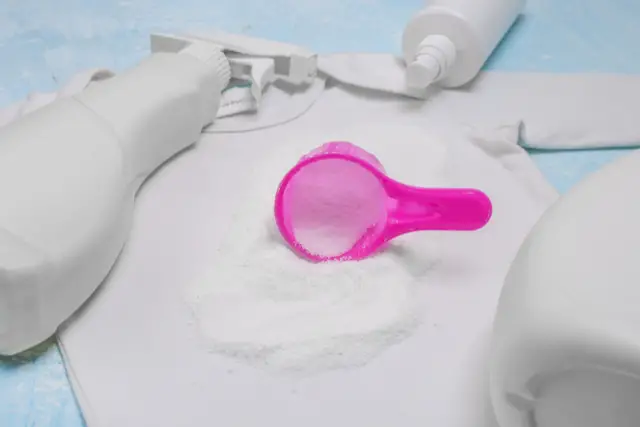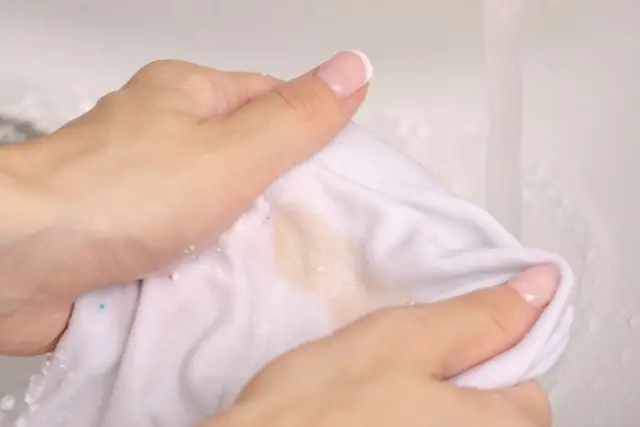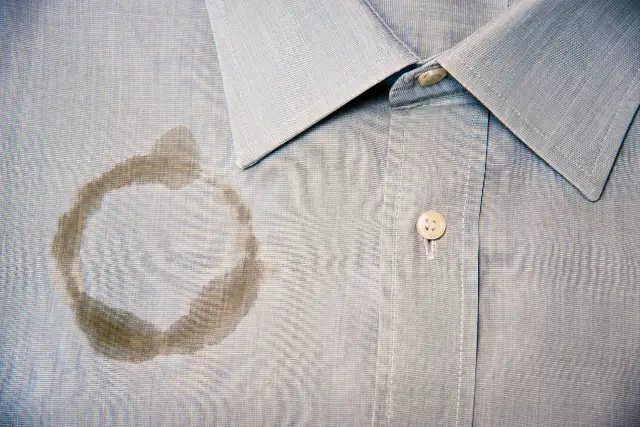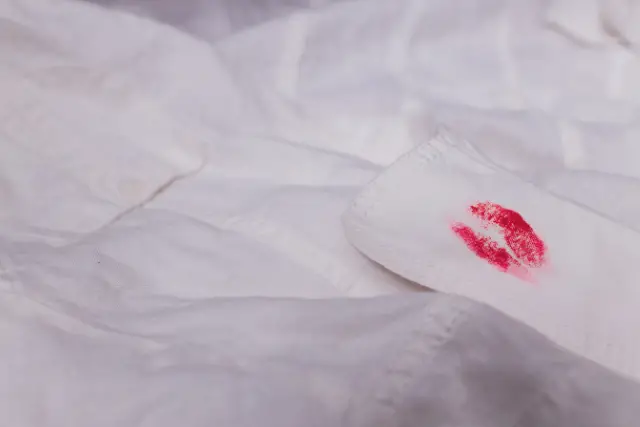Whether it’s a drop while cooking or a spill during a skincare regimen, coconut oil can seep into fabric fibers and create a stubborn mark. Understanding how to tackle these stains promptly can preserve the life of your favorite garments and prevent the oils from setting permanently.
Successfully removing coconut oil stains from clothes requires a specific approach, since treating these stains like any other may not be effective.
In this post, we’ll guide you on how to get coconut oil out of clothes. Learn quick tricks and tips to treat and wash away coconut oil stains without ruining your stained clothes.
Key Takeaways
- Act quickly to prevent coconut oil from setting into fabrics.
- Utilize pre-treatment methods to break down the oil before washing.
- Wash with appropriate detergents and temperatures to fully remove the stain.
What makes coconut oil stain on clothes
Removing coconut oil stains can be tricky due to the unique properties of the oil and the challenges it poses when it comes into contact with various fabrics.
Properties of Coconut Oil
Coconut oil is rich in saturated fats, which lend it a highly stable structure, making it less prone to damage from heat and light. This stability, beneficial for health and skincare, also means that coconut oil has a higher tendency to solidify at cooler temperatures and adhere to fabric fibers.
When you spill coconut oil on your clothes, the fats interact with the fibers, creating a bond that’s not easily dissolved by water alone.
Challenges with Oil Stains on Clothes
Oil stains stand out on clothes due to oil’s hydrophobic nature — it repels water instead of mixing with it. As a result, once coconut oil seeps into the fabric, it creates a stubborn stain that standard laundering can’t always remove.
Fabrics like cotton and linen are particularly prone to holding onto oil stains because their fibers have numerous small spaces for the oil to penetrate deeply. Synthetic fibers also present a challenge as they can react differently to oil, making the stain removal process less straightforward.
Quick Tricks to Remove Coconut Oil Spills

When coconut oil spills onto your clothing, acting promptly can prevent the stain from setting. Begin by addressing the spill with absorbent materials and pre-treatment methods.
Blotting the Stain
Once you notice a coconut oil spill on your clothing, resist the urge to rub the fabric which can drive the oil deeper into the fibers. Instead, gently blot the stained area with a paper towel to remove as much excess oil as possible. Take care not to spread the oil further.
Absorbing Excess Oil
After blotting, generously sprinkle absorbent powder, such as cornstarch, baby powder, or talcum powder, on the oil stain. This will help to absorb any lingering oil. Cover the stain completely with the powder and softly press it into the fabric. Allow it to sit for at least 15 minutes before brushing the powder away.
Pre-Treatment Methods
Effective pre-treatment is crucial when removing coconut oil stains from clothing. By addressing the stain as quickly as possible and applying the right substances, you can significantly improve the odds of eliminating the stain.
Using Common Household Items
To begin with, blot the excess coconut oil using a clean cloth or paper towel—this will remove as much oil as possible before the actual cleaning process. Then, items readily found in your home such as baking soda or cornstarch can be used to absorb the remainder of the oil.

Generously sprinkle the powder onto the stain and let it sit for at least 10 to 15 minutes before brushing it away. Following this, apply a small amount of dishwashing liquid or liquid laundry detergent directly onto the stain, gently rubbing it in to help break down the oil. For tougher stains, a combination of vinegar and baking soda can create a paste that you can apply to the stain before laundering.
Applying Stain Removers
For stronger pre-treatment options, an enzyme-based stain remover is especially effective against oil stains. These stain removers are formulated to break down the oil and can be applied directly to the stain.
Ensure the product is compatible with the fabric, and allow it to sit on the stain for the recommended time—typically 15 to 30 minutes. Pre-treatment with a specialized stain remover usually makes the subsequent laundering more effective in removing any residual stain.
Washing and Removing Stains

When dealing with coconut oil stains on clothing, the removal process differs significantly between machine washing and hand washing delicate fabrics. Carefully select your approach based on the garment’s material and the severity of the stain.
Machine Washing Techniques
Immediate Action:
- Remove excess oil: Gently scrape off any excess coconut oil without spreading it further.
- Pre-treat the stain: Apply an enzyme-based pre-treatment directly to the stain and let it sit for at least 15 to 30 minutes.
Washing Steps:
- Set your washing machine on the hot water cycle, which helps to dissolve oil more effectively.
- Use a high-quality laundry detergent, ideally one designed to cut through grease.
| Washing Machine Step | Guidance |
|---|---|
| Cycle Selection | Choose the hot water cycle. |
| Detergent Type | Opt for a grease-fighting formula. |
| Post-Wash Inspection | Check the stain before drying. |
Do not place the garment in the dryer if the stain is still visible, as heat can set it permanently.
Hand Washing Delicate Fabrics
Stain Removal:
- Mix a small amount of mild dish soap with hot water.
- Use a soft cloth to apply the solution, gently blotting from the edge toward the center of the stain.
Hand Washing Delicate Fabrics:
- Fill a basin with cold water and add a teaspoon of detergent.
- Submerge the fabric, gently agitate with your hands, then rinse thoroughly with cold water.
| Hand Washing Step | Instructions |
|---|---|
| Detergent | Use a mild detergent suitable for delicates. |
| Water Temperature | Start with cold water to avoid shrinking or damage. |
| Drying | Lay flat or hang to air dry away from direct heat or sunlight. |
Always refer to the fabric care label to ensure the selected method aligns with the garment’s washing instructions.
Special Techniques for Stubborn Stains

Some coconut oil stains can be particularly resistant to treatment, especially if they are old or have set into the fabric. The following methods utilize specific solvents and advanced techniques geared toward breaking down these stubborn stains effectively.
Using Solvents
Rubbing Alcohol: To tackle older coconut oil stains, apply rubbing alcohol directly to the stain before washing. It helps break down the oil and can be particularly effective on synthetic fabrics.
- Dab rubbing alcohol onto the stain using a cotton ball or cloth.
- Allow it to sit for a few minutes to break down the oil.
WD-40: Surprisingly, WD-40 can also be used to treat old oil stains. It acts as a solvent to dissolve the oils in coconut oil.
- Spray a small amount of WD-40 onto the stain.
- Let it sit for 15-30 minutes, but do not let it dry completely.
- Wash the clothing item as usual, checking the fabric care label for any specific instructions.
Advanced Stain Removal Methods
Oxygen Bleach: An eco-friendly option, oxygen bleach is safe for colorfast fabrics and effectively removes old and stubborn oil stains.
- Mix oxygen bleach with warm water as directed on the product’s packaging.
- Soak the garment for up to eight hours, checking occasionally to see if the stain is lifting.
Hydrogen Peroxide: As a mild bleaching agent, hydrogen peroxide can help lighten old coconut oil stains on light-colored fabrics.
- Apply a mixture of 1 part hydrogen peroxide to 2 parts water directly to the stain.
- Allow it to sit for no more than an hour to avoid potential fabric damage.
Remember to test these solvents on an inconspicuous area of the garment first to ensure colorfastness and fabric integrity.
Taking Care of Different Fabrics

When removing coconut oil from clothes, it’s crucial to consider the fabric type. Each material requires specific care to avoid damage while efficiently removing the stain.
Approaches for Cotton and Linen
Cotton and linen are sturdy, natural fibers that can typically handle more rigorous cleaning methods. Before applying any treatment, check the care label to ensure the fabric can tolerate hot water, which helps break down oil:
- Cotton: Pre-treat with an enzyme-based stain remover for 15 to 30 minutes. Then, wash using hot water if the care label permits.
- Linen: For fresh stains, absorb excess oil with a paper towel. Apply a liquid detergent and gently rub it in. Wash in hot water if the garment’s care label allows.
Handling Synthetic and Delicate Fibers
Synthetic and delicate fibers like polyester and silk require gentle handling to avoid damaging the garment:
- Polyester: Blot the stain and pre-treat it with a mixture of dish soap and warm water. Wash in the warmest water recommended on the care label.
- Silk: Tackle stains on silk carefully. Blot and apply a gentle solution of lukewarm water and mild detergent. Test a small area first to ensure the fabric’s colorfastness. Wash according to the care label’s instructions, often recommending hand washing or a delicate machine cycle.
Finishing Touches
Once the stain removal process is complete, proper drying and odor checks are vital steps to ensure that your clothes are as good as new.
Air Drying and Inspection
To preserve the state of your clothing after treating a coconut oil stain, air drying is the method of choice. Hang your garment in a well-ventilated area away from direct heat or sunlight which could set any remaining oil. Once dry, inspect the fabric. The previously stained area should be indistinguishable from the rest. If a slight discoloration persists, you may need to treat the area again before air drying.
Addressing Remaining Oil Odor
If the smell of coconut oil remains:
- Prepare a vinegar solution by mixing one part distilled white vinegar to four parts water.
- Soak the affected area of the garment in the solution for 15 minutes.
- Rinse thoroughly with water to remove the vinegar smell.
Remember, the key is to neutralize the scent without leaving behind a new one.
Frequently Asked Questions
In tackling coconut oil stains on your clothes, you might encounter a few common challenges. The questions below cover methods that can help you effectively address these issues.
What methods can remove coconut oil stains from clothes after drying?
If the coconut oil stain has dried, start by gently scraping off any solid residue. Apply a pre-treatment like an enzyme-based stain remover or liquid laundry detergent to the area. Let it sit for at least 15 to 30 minutes before washing with hot water, which aids in dissolving the oil. Be cautious of the fabric’s heat tolerance to avoid damage.
How can I remove coconut oil from bed sheets?
Removing coconut oil from bed sheets involves blotting out as much oil as possible using white towels or paper towels, and then treating the stained area with liquid laundry detergent. Work the detergent into the fabric and let it sit for some time. Wash the sheets in hot water, checking the care label first, and avoid placing them in the dryer until the stain is completely gone.
Are there effective techniques to deal with coconut oil residue on garments?
For coconut oil residue, sprinkle baking soda or cornstarch on the stain and allow it to absorb the oil for up to an hour. Brush away the powder, and then apply a pre-treatment solution to the stain. Launder the garment using the hottest water setting appropriate for the fabric. This method helps break down and lift the oil, reducing residue.



